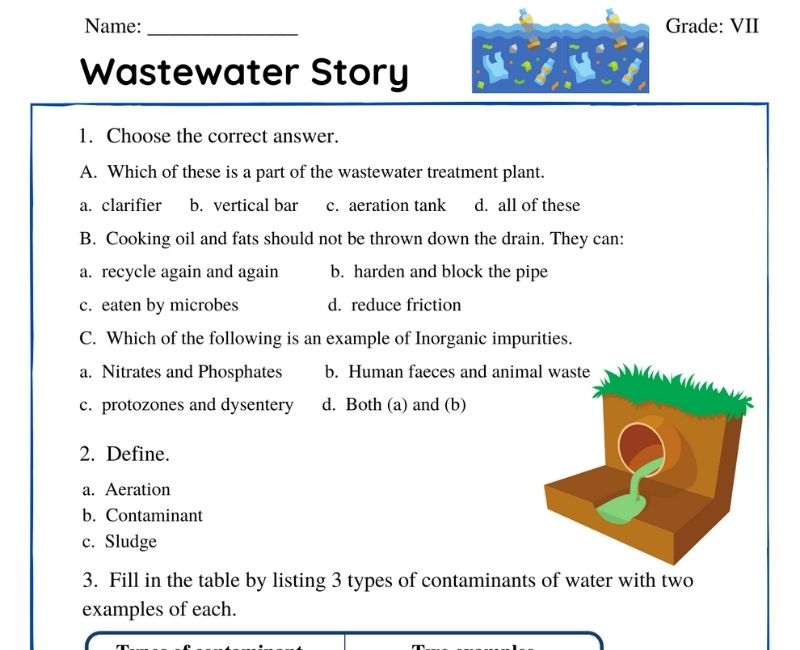CBSE Class 7 Wastewater Story Worksheet Including MCQs
Dive into the murky depths of the Wastewater Story, a crucial adventure laid out in class 7, chapter 13 of the science curriculum, where students are beckoned to embark on a revealing journey into the world of wastewater management.
This chapter not only sheds light on the significance of treating and recycling wastewater but also equips the young minds of class 7 with the knowledge and understanding to appreciate the intricacies of this vital process. The tailored worksheets designed for the Wastewater Story class 7 worksheet provide a comprehensive guide through the maze of wastewater treatment, inviting students to explore each step, from collection to treatment, and finally, safe disposal or reuse.
As learners navigate through the lessons, the Wastewater Story class 7 worksheet acts as a beacon, illuminating the path with engaging activities that reinforce the subject matter. These worksheets are not mere paper tasks; they are doorways to critical thinking and environmental stewardship, challenging students to ponder over solutions for real-world problems caused by untreated wastewater.
The class 7 science chapter 13 goes beyond textbook learning, offering myriad questions with answers that encourage students to delve deeper into the topic. With each query, learners are pushed to analyze and apply their newfound knowledge, fostering a proactive approach to learning. The vibrant, thought-provoking questions serve as a bridge, connecting theoretical knowledge with practical applications, making the science of wastewater treatment accessible and intriguing.
Moreover, the adventure into wastewater doesn't stop at standard coursework. The class 7 science wastewater story extra questions push the boundaries of curiosity, prompting learners to investigate further into the subject. These extra questions, meticulously crafted, help cement the concepts taught, ensuring that the knowledge gained sticks with students long after they’ve left the classroom.
Embarking on this journey through the Wastewater Story, students aren't just passive recipients of information; they become active participants in a critical dialogue about water conservation and environmental protection. It's a chapter that goes beyond science, instilling in them a sense of responsibility towards our planet. Through the lens of witknowlearn, this exploration becomes not just educational but transformational, cultivating informed, mindful individuals ready to make a difference in the world.
Wastewater Story Class 7 Worksheet from Witknowlearn
The Wastewater Story class 7 worksheet from Witknowlearn introduces a transformative learning experience, engaging students in the critical subject of wastewater management through interactive and comprehensive activities. This worksheet is meticulously designed to align with the objectives of class 7 science chapter 13, ensuring a deep and practical understanding of wastewater treatment processes. As students navigate through the assignments, they are encouraged to think critically about the impacts of wastewater on our environment and the importance of sustainable practices. By integrating real-world scenarios, Witknowlearn’s worksheet transforms traditional learning into an immersive journey, fostering environmental stewardship among young learners.
Wastewater Story Class 7 Questions with Answers
Delving into the Wastewater Story class 7 questions with answers provides an excellent opportunity for students to test their knowledge and comprehension of the chapter. These questions, coupled with comprehensive answers, serve as an effective revision tool, helping students solidify their understanding of key concepts such as the significance of wastewater treatment and the various methods employed in the process. By tackling these questions, learners gain confidence in their ability to recall information and apply it in various contexts, thus enhancing their academic performance and fostering a deeper appreciation for the science underlying wastewater management.
Class 7 Science Wastewater Story Extra Questions
Exploring the class 7 science Wastewater Story through extra questions pushes the boundaries of conventional learning, challenging students to delve deeper into the complexities of managing wastewater efficiently. These additional queries are crafted to stimulate curiosity and provoke thoughtful discussions, encouraging learners to explore beyond the textbook. Addressing these extra questions enables students to gain a more nuanced understanding of environmental science and the pivotal role of wastewater treatment in preserving our water resources. This approach not only reinforces their grasp of the subject matter but also cultivates critical thinking skills and a lasting awareness of environmental issues.





